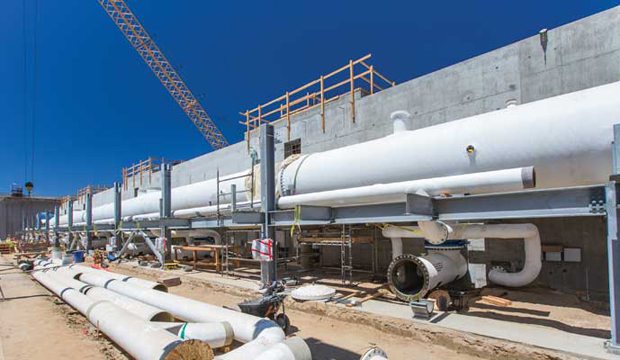Pipe & Tank Applications
FRP pipe and tank installations are on the rise – above and below ground, in commercial, municipal and residential applications. Low-cost natural gas leads to the development of new chemical facilities and the expansion of older ones for chemical processing. That, in turn, creates demand for FRP pipes.
Composite Rainwater Tanks Contribute to LEED Platinum Rating

- Application: Underground rainwater harvesting tanks
- Scope: Two 20,000-gallon GFRP tanks
- Year Introduced: 2009
- Volume: Hundreds of tanks per year
- Process: Chopped spray inside a closed mold
Composite tanks help provide clean drinking water to homeowners
When a Texas couple wanted to build an environmentally-friendly home, underground water storage tanks made from composite materials helped them earn a Platinum LEED (Leadership in Energy and Environmental Design) rating from the U.S. Green Building Council. Platinum is the highest LEED rating a building can receive.
Since their area of Texas is prone to droughts, the homeowners wanted to capture every drop of rainwater possible to use as potable water. But with space tight on their half-acre building site, they didn’t want to install the typical above-ground water storage tanks. Instead, they chose Xerxes® Corporation to manufacture two 20,000-gallon GFRP water tanks for burial below ground. The only thing visible aboveground is the manhole needed to access and service the tank’s pumps.
The GFRP tanks are NSF International certified, which means that they meet the U.S. standards for drinking water use. They are made of a resin catalyst with chopped strand glass reinforcement. To construct the tanks, Xerxes uses a unique chopped manufacturing process inside a rotating closed mold. A cantilevered platform holding the sprayer extends inside the mold as it rotates, so the chopped spray strikes the mold’s inside surface. The process takes two to three days from the start of fabrication through final assembly.
Despite their size, the composite tanks are relatively lightweight, which makes them easier to transport and install than metal storage tanks.
The stored rainwater goes through a three-step filtration process before it enters the home’s plumbing system. All of the homeowner’s potable water now comes from rainwater collected in the composite tanks.
